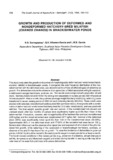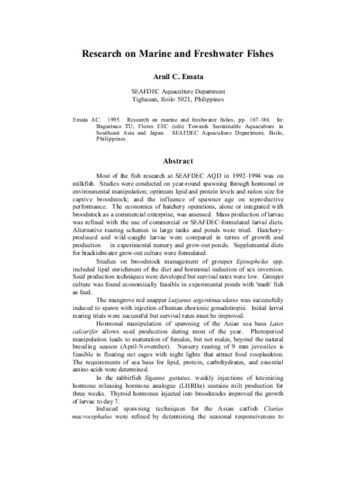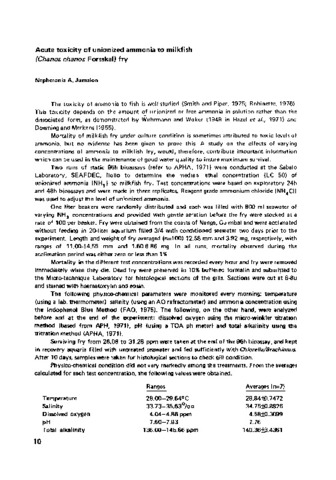Growth and production of deformed and nondeformed hatchery-bred milkfish (Chanos chanos) in brackishwater ponds
- Global styles
- MLA
- Vancouver
- Elsevier - Harvard
- APA
- Help

View/Open
Date
1999Page views
3,036ASFA keyword
AGROVOC keyword
Taxonomic term
Metadata
Show full item recordShare
Abstract
This study evaluated the growth and survival of morphologically deformed and nondeformed hatchery-bred milkfish in brackishwater ponds. It compared the size-frequency distribution of the nondeformed fish with the deformed ones, and determined the effects of different types of deformity on growth. The deformities include the absence of an upper jaw, a folded operculum with gills exposed, a cleft branchiostegal membrane, scoliosis, etc. The results were compared with production of wild stock. Hatchery-bred and wild milkfish fry were grown separately in nursery ponds (500 m2/pond) at 10 individuals/m2. After a month, the juveniles (average weight hatchery-bred 6.0 g; wild 9.5 g) were transferred to seven rearing ponds of 1000 m2 each (stocking density 3000/ha). Three ponds were stocked with selected, nondeformed hatchery-bred fish (unmixed stock), three ponds with a combination of deformed and nondeformed hatchery-bred fish (1:2 ratio; mixed stock), and one pond with wild fish. The final weight, specific growth rate and survival of the nondeformed fish (mixed and unmixed stock) after four months of culture were significantly higher (p<0.05) than those of the deformed fish. Production, however, did not significantly differ between the unmixed nondeformed (433 kg/ha) and the mixed deformed and nondeformed (377 kg/ha) fish. Survival of the deformed stock (56%) was significantly lower (p<0.05) than that of the nondeformed stock (86-88%). Approximately 92% of the deformed stock and 17-20% of the nondeformed were below 150 g. Severe deformities such as the absence of an upper jaw and exposure of all or most of the gills hindered fish growth, while widening of the operculum or branchiostegal membrane, scoliosis, or absence of the anal fin had less effect on growth. To lower the incidence of deformities in grow-out ponds, milkfish fry should be reared to the early juvenile stage in nursery ponds for at least a month. The harsh natural conditions in the nursery ponds (e.g., presence of predators, abrupt changes in salinity, temperature and dissolved oxygen) and stress during transfer to rearing ponds may eliminate most of the weak fish and those with severe deformities.
Suggested Citation
Sumagaysay, N. S., Hilomen-Garcia, G. V., & Garcia, L. M. (1999). Growth and production of deformed and nondeformed hatchery-bred milkfish (Chanos chanos) in brackishwater ponds. The Israeli Journal of Aquaculture-Bamidgeh , 51(3), 106-113. http://hdl.handle.net/10862/995
Type
ArticleISSN
0792-156XCollections
- Journal Articles [1249]
Related items
Showing items related by title, author, creator and subject.
-
Research on marine and freshwater fishes
Emata, Arnil C. (Aquaculture Department, Southeast Asian Fisheries Development Center, 1995)Most of the fish research at SEAFDEC AQD in 1992-1994 was on milkfish. Studies were conducted on year-round spawning through hormonal or environmental manipulation; optimum lipid and protein levels and ration size for ... -
Experiments on the induced spawning and larval rearing of the milkfish, Chanos chanos (Forsskal) in 1979
Juario, J. V.; Natividad, M.; Quinitio, G.; Banno, J. (Aquaculture Department, Southeast Asian Fisheries Development Center, 1979)This paper summarizes the results of the experiments on the induced breeding and larval rearing of milkfish during the 1979 season. -
Acute toxicity of unionized ammonia to milkfish (Chanos chanos Forsskal) fry
Jumalon, Nepheronia A. (Aquaculture Department, Southeast Asian Fisheries Development Center, 1979)






